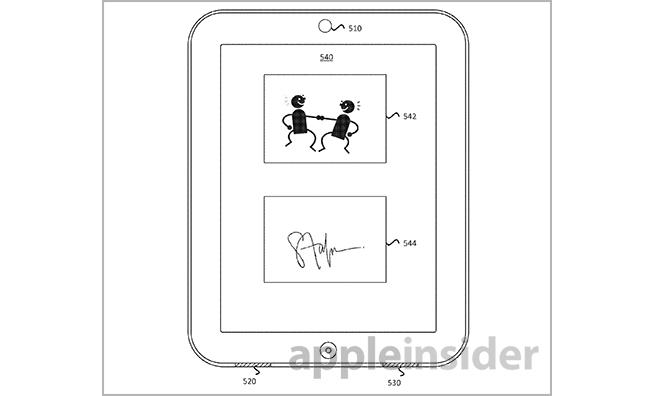A peculiar Apple invention landed on the U.S. Patent and Trademark Office's desk on Thursday, describing a method in which an author or artist can digitally autograph a fan's ebook or other digital media using a special app.

Source: USPTO
With the iBookstore, an iOS device user can essentially carry thousands of books in their pocket, each stored on board or in the cloud for immediate access. However, while extremely convenient and highly portable, ebooks simply can't replicate certain traits retained by bound books, like the feel of turning a page, quickly flipping through chapters and, as Apple points out in its patent filing, collecting an autograph.
Aside from asking an author to sign an iPad or iPhone, users are left with little recourse beyond purchasing a physical copy of a book, should they want an autograph from their favorite writer. The same goes for other digital media like movies and music.
Apple addresses the issue in a patent application for "Embedding an autograph in an electronic book." As noted in the document, electronic media has numerous advantages over their paper and ink counterparts, such as interactivity, additional content like video or audio and the ability to easily share snippets with friends, among others.
However, some still prefer physical copies, one of the reasons being that paper media can be personalized with autographs, for example. Autographed copies of books or album covers can hold special meaning to the reader and Apple wants to reproduce at least some of that significance by embedding personalized digital signatures in a digital medium.
While the patent application focuses primarily on ebooks, it is clearly noted that the technology can extend to the aforementioned digital formats, as well as any other media stored on an electronic device.
Example of autograph transfer in a group setting.
In practice, the method of embedding an autograph starts with the user's device. Apple's provided example describes an ebook download that comes with an authorized autograph page included by the publisher.
Some embodiments restrict the autograph to a specific page or "hotspot" where the author can sign, while other methods allow the user to choose the insertion point. Alternatively, if there is no autograph page or hotspot, the author or content creator with appropriate permissions can generate the field via a specialized app such as iBooks Author.
To issue an autograph, an author's device must have the appropriate credentials and, in most cases, be in close proximity to the device receiving the signature. Transfer takes place over Bluetooth or other wireless protocol to a single device, or multiple devices depending on the situation.
Illustration showing devices inside and outside of autograph transfer range.
Important to any autograph is authenticity, both for a user and the person giving away their signature. In some embodiments, a certificate is sent along with the autograph that verifies the content as legitimate. This digital marker can be stored on the recipient's device or remotely on a server like iCloud. When a user synchronizes their ebook library, the digital token is passed along, thereby securing the authenticity and uniqueness of the autograph.
Building on cloud support, autographs can first be sent to the cloud for authentication and encryption, then sent to the recipient devices. The appropriate credentials and safeguards would also be passed along in the transfer.
Finally, the patent describes virtual signings that may take place over the Internet. In this case, identification keys and encrypted signature are transferred to a specific device, the identifier of which is recorded and attached to the accompanying certificate.
Interestingly, the filing notes that an "autograph" can take the form of any other digital media fit for storage and display on a user's device. For example, a photo with the author or a recorded soundbite can be clipped to the autograph page.
It is unclear what Apple plans to do with the digital autograph system, but the technology is in place to roll out such a feature if the company so chooses.
Apple's autograph embedding patent application was first filed for in 2012 and credits Casey Maureen Dougherty and Melissa Breglio Hajj as its inventors.

